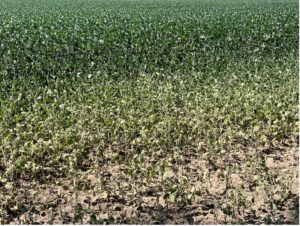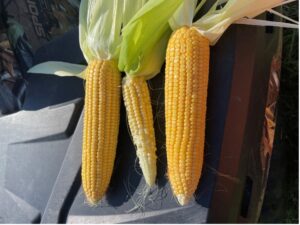Nick Seiter, Extension Field Crops Entomology Specialist, University of Illinois
As many soybean fields start to reach R5, begin scouting for stink bugs. Populations appear to be elevated in some areas; economic threshold is 9 per 25 sweeps or 1 per row-ft. Spider mites continue to be found in isolated areas that are experiencing drought stress.
Talon Becker, Commercial Agriculture Extension Educator, Southern IL
In South Central IL, crop conditions are still good in most fields. There has been minimal rainfall in this area of the state for the past couple weeks, which was actually welcome after a particularly wet period in the preceding two weeks. Heavy rains in late July in the section of the state between Jefferson County and Shelby County have taken their toll, with drowned crops in some low-lying areas. Even if crops were not killed by submerged roots and a subsequent lack of oxygen, saturated soils in these areas may also lead to increased risk for soil-borne diseases, particularly of soybean, setting in at this time of year.
Nathan Johanning, Commercial Agriculture Extension Educator, Southwestern IL
We are enjoying a much needed break in the excessive heat and humidity over the last week. Our area did get roughly a half inch of rain earlier in the week. With that and most areas receiving heavier rains in prior weeks, our soil moisture levels are in a much better place now than they were a month ago. Crops are progressing well. Many are starting to put together plans for any potential fall cover crops or wheat they might need.
Chelsea Harbach, Commercial Agriculture Extension Educator, Northwestern IL
The past week had quite temperate weather in Western Illinois. While I continue to receive reports of diseases showing up in corn (tar spot, southern rust), we are well past the point in which it is economically reasonable to spray more fungicides on any fields. Don’t let new sightings or reports of disease scare you into making an economically irresponsible decision.
Russ Higgins, Part-time Commercial Agriculture Extension Educator, Northeastern IL
Northeastern Illinois is a land of have and have nots, fortunate and not so fortunate. Instead of baseball, we are talking about precipitation. Several areas (mostly northern counties in the NE region) have recently caught consistent and timely rains and their crops reflect almost ideal growing conditions. Isolated areas, including the southern edge of the NE region have missed rain after rain. Harvest this year will truly reflect the water use efficiency of modern corn hybrids and soy varieties.
One can always learn from scouting trips to the field, even late season. Much of the corn is nearing dent (R5), I am surprised at the lack of leaf disease pressure in the corn in 2022. It is understandable that environmental conditions have not favored Gray leaf spot or Northern leaf blight, but I am most confounded by the absence (to date) of Tar spot symptoms. This disease has been almost a given, regardless of environmental conditions in recent years in Northeastern Counties. Soybean are full pod to beginning seed (R4-R5). In areas that are still very dry, Spider mites continue to be a concern.

This year, some of the earliest planted corn struggled to emerge uniformly, primarily due to crusted soils and soil temperatures following a significant April rain event prior to corn emergence. The importance of uniform emergence becomes apparent at this time of the year. The image below shows ears collected from three consecutive corn plants. The middle plant emerged later and lagged behind its neighboring plants resulting in an undesirable ear and kernel count. Hopefully this weekend will bring moisture to areas that need it in Northern Illinois.

Weston Olson, ILSoyAdvisor Soy Envoy
Crops continue progressing at a good pace and still look great in the field. Nothing is really stressed or damaged as we have had a great growing year. The results (yield) will be interesting as we should be doing close to record crops in our area but we never know until the combine goes through. The only issue is next year inputs as much as we make this year unfortunately will have to dole out more to get a crop next year. There has to be a breaking point in this whole mess, and unfortunately we’re not seeing it yet.




 and then
and then